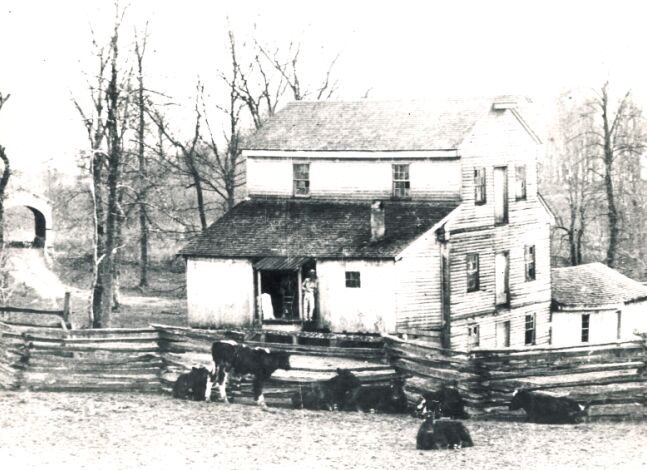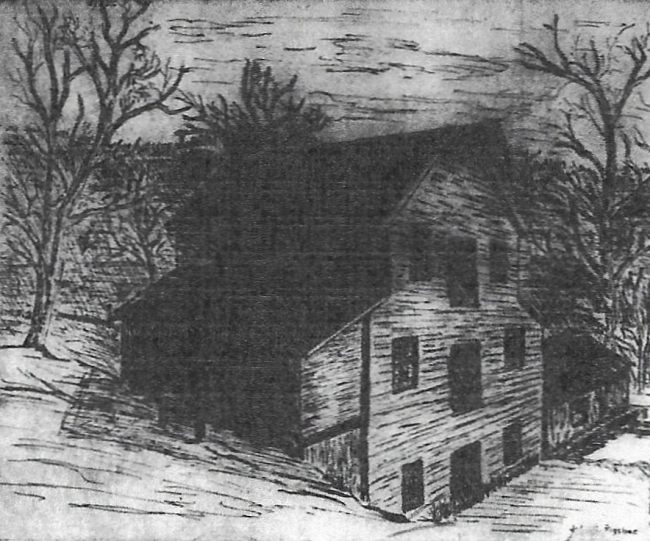Picture Gallery
Family Albums
Barnard

This mill was located in the southwest part of Posey Township in Rush County. The mill was just north of Swain's Mill Bridge over the Little Blue River. The Barnard property was south of the mill. Sharon Theobald Rensberger has many land records from the Joseph Macy family, who seemed to have purchased the mill property more than once. Sharon contributed the newspaper article below.
The Rushville Republican
Rush County, Indiana
Monday, April 17, 1972
Page 8
----------

Old Swain Mill by Rush County Artist in Sesqui Sketch Book
----------
John E. Rigsbee, the Arlington Junior High School art stufent, son of John H. and Carol Rigsbee, has sketched from an old photo this outstanding likeness of the Old Swain Mill. The subject is not to be wondered at as all of John's young life has been spent within the haunting historical shadow of the structure; haunting, because nothing but the earth and stonework siste of the dam, pond and mill building remain of the once flourishing enterprise. The mill was located on Little Blue River in the northwest corner of Posey Township at CR 425W and Base Road. A Kennedy covered bridge erected in 1921 completed the scene.Rush County, Indiana
Monday, April 17, 1972
Page 8
----------

Old Swain Mill by Rush County Artist in Sesqui Sketch Book
----------
Is it possible that modern youth holds the slightest credence in the occult? If this generation is not too sophisticated to tune in one the midnight whisperings of legendary Rush County, some freak spockish stands might emanate from this locale. Perhaps John and some fillow apparition hunters Huck Finn-like will seek out the uncany grass of the ancient water wheels. Or maybe the eerie spectral whine of the long stilled saws will bring out the goose pimples. Surely no self-respecting ghost town such as Sumner P. O. blessed with a creaking mill wheel and a covered bridge echoing the hoof clatter ages gone can be without its hint of historic foul play and neighborhood phantom.
Early Rush County relied on its streams for mechanical power. At one time there were twenty-nine water owered mills located on Flatrock River alone. Big and Little Blue River, Ben Davis Creek, Little Flatrock and many other waterways provided the natural power for mill wheels.
We are indebted to Bert Rigsbee who provided us with a copy of "History of the Old Swin Mill," written in 1916 by Roy Swain of Posey Township. It is here reproduced in full.
"The Rush County Artists Notebook 1822-1972" with the above sketch and 126 other drawing by local artists is available from members of the Creative Arts Association of Rush County and selected retail merchants in Rushville and Homer.
History of the Old Swain Mill
The story of our old citizens ... interesting memories of ... the old, old days surrounding the old Swain mill, which was one of the first building to be erected in Rush County. In 1833 in the little town of Sumber in Posey Township, Thomas Swain built a saw mill, and ten years later a grist mill was added to it. At first only corn was ground there, but in 1848 wheat burrs were put in by Alfred Swain and Thomas Macy, William Worth doing the carpenters work. The lumber for this addition was all sawed at the old saw mill.
... from the start, and was run day and night, netting the owners a clear profit of $25 every twenty-four hours.
Most of the lumber used in building the houses, barns and other building for many miles around was sawed at the old mill, and people came from long distances to have their corn and wheat ground at the grist mill. The lumber for the old Wesleyan Church was also sawed at the mill.
During the year 1875 the old saw mill was town down and the grist mill was repaired at a cost of $2,000, which was all made back in one year.
There were three dams built, the first, being erected in 1833. This was made of logs and was built square up. The second, in 1852, was a brush dam; first a layer of logs, then brush and gravel, and then logs, etc. The third was built in 1875 when the mill was repaired.
The head and tail races were dug by one man with pick, mallack and shovel. The man doing the work was named Isnogle [Icenogle today?]. He dug it for $1.00 a rod and there were 220 rods in the job. The job was a big one and it took him all summer complete it.
The first wheel was a paddle-wheel and it was used for six years. Then an overshot wheel six feet in diameter and twenty feet long was put in and it saw service for eleven years. The next was a turbine wheel which was used for fifteen years. When the mill was repaired in 1875, a tub wheel of cast iron was put in, and it was used for twenty-five years.
When the commissioners came to pick out the spot for the bridge across Little Blue, the bridge was built crooked, as the road ran around the mill, and while the mill has not been running for ten years, the bridge has never been changed.
In 1900 [?] when the estate of Benjamin Franklin Folger was settled, the mill was sold at public auction to Joseph Macy for $2,200. The mill was sold at different times, bringing the following prices, $1,000, $4,000, $2,200 and $3,000.
The old mill was in operation for 57 years, and during that time the following men were its owners: Thomas Swain; his thre[sic] boys, Frank, Alonzo and Alfred Swain; Tristram Macy, Joseph Macy; Brazilla [Barzillia] Barnard; Lather Folger; James Browning; Clark Macy; Benjamin Franklin Folger and James Branson.
After the mill quit running, James Branson used it for a barn. On the 11th of March, 1900, while in there milking, Mr. Branson heard the old building crack, and he had no more than got safely out when the old structure fell. The cow was not killed, but received a few injuries.
Only four of they men who were at one time owners of the mill are living, at the time of this writing and they are Alfred Swain, James Branson Luther Folger, Joseph A. Macy.
 History Index
History Index  Main Page
Main Page